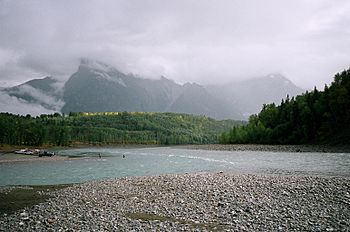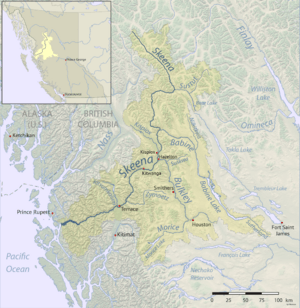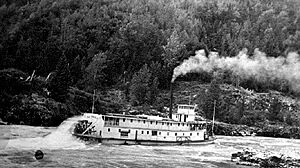Skeena River facts for kids
Quick facts for kids Skeena River |
|
|---|---|

The Bulkley River (left) flowing into the Skeena River (right) near Hazelton
|
|

Skeena River watershed with tributaries
|
|
| Country | Canada |
| Province | British Columbia |
| City | Terrace |
| Physical characteristics | |
| Main source | Spatsizi Plateau 57°9′6″N 128°41′29″W / 57.15167°N 128.69139°W |
| River mouth | Pacific Ocean Chatham Sound 0 m (0 ft) 54°8′15″N 130°5′40″W / 54.13750°N 130.09444°W |
| Length | 570 km (350 mi) |
| Basin features | |
| Basin size | 54,400 km2 (21,000 sq mi) |
| Tributaries |
|
The Skeena River is the second-longest river that is completely inside British Columbia, Canada. Only the Fraser River is longer. For a very long time, the Skeena has been an important travel route. It was especially important for the Tsimshian and Gitxsan peoples. Their names even connect to the river. "Tsimshian" means "inside the Skeena River," and "Gitxsan" means "people of the Skeena River."
The river and its surrounding area are home to many kinds of fish, wildlife, and plants. The local communities depend on the river to be healthy. The Tsimshian people moved to the lower part of the Skeena River. The Gitxsan people live in the upper Skeena area.
During the Omineca Gold Rush, steamboats traveled from the ocean up to Hazelton. Hazelton was the starting point for trails leading to the goldfields. The Hudson's Bay Company also set up a big trading post on the Skeena. This place became known as Port Simpson. Nine tribes of the Tsimshian nation settled there around 1834.
Contents
Where is the Skeena River?
The Skeena River starts in the northwestern part of British Columbia. It begins south of the Spatsizi Plateau Wilderness Provincial Park. It flows for about 570 km (350 mi) before it reaches the Pacific Ocean. The river empties into Chatham Sound, Telegraph Passage, and Ogden Channel.
The Skeena River drains a large area of land, about 54,400 km2 (21,000 sq mi). On average, it carries about 1,760 cubic metres per second (62,000 cu ft/s) of water each second.
The River's Journey

The Skeena River begins in a valley on the southern end of the Spatsizi Plateau. It flows southeast through the Skeena Mountains. Then it turns west and later south through a canyon. After passing Kuldo, it turns east, then south again.
It continues through hills to the communities of Kispiox and Hazelton. In Hazelton, it joins with the Morice-Bulkley River. From there, it turns southwest. The Yellowhead Highway and a Canadian National Railway track follow the river along this part of its journey.
At Kitwanga, Highway 37 crosses the river. The river then flows south around the Seven Sisters Peaks. It passes through the Skeena Provincial Forest and the Kitselas Canyon. Finally, it flows southwest through the city of Terrace, where the river becomes wider. It continues west, passing near the Exchamsiks River Provincial Park. The river then flows into the Dixon Entrance at Eleanor Passage, near Port Edward and Port Essington.
Rivers Joining the Skeena
Many smaller rivers and creeks flow into the Skeena River. These are called tributaries. Here are some of them:
- Upper Skeena: Bear River, Johanson Creek, Shilahou Creek, Slamgeesh River, Sustut River
- Middle Skeena: Babine River, Boucher Creek, Buck Creek, Bulkley River, Comeau Creek, Cullon Creek, Date Creek, Deep Canoe Creek, Fulton River, Harold Price Creek, Kispiox River, Kitseguecla River, Maxan Creek, McCully Creek, McQueen Creek, Morice River, Nangeese River, Nanika River, Nilkitkwa River, Pinkut Creek, Richfield Creek, Shegunia River, Simpson Creek, Stephens Creek, Suskwa River, Sweetin River, Toboggan Creek
- Lower Skeena: Alwyn Creek, Big Falls Creek, Cedar Creek, Coldwater Creek, Copper River, Deep Creek, Dog Tag Creek, Ecstall River, Erlandsen Creek, Exchamsiks River, Exstew River, Fiddler Creek, Gitnadoix River, Goat Creek, Johnston Creek, Johnston Lake, Kaeen Creek, Kasiks River, Khyex River, Kitsumkalum River, Kitwanga River, Kleanza Creek, Lakelse River, Lean-To Creek, Limonite Creek, Magar Creek, Moonlit Creek, Salmon Run Creek, Sockeye Creek, Spring Creek, Star Creek, Thomas Creek, Trapline Creek, White Creek, Williams Creek, Zymagotitz River, Zymoetz River
Animals and Plants of the Skeena
The Skeena River area is home to many different kinds of fish and wildlife. The British Columbia Ministry of the Environment has set aside special areas along the river called Ecological Reserves. These areas help protect the natural environment.
Fish in the River
The Skeena River is famous for sport fishing, especially for salmon. It is also very important for the commercial fishing industry. For example, about 5 million sockeye salmon return to the Skeena each year to lay their eggs. This makes it the second-largest sockeye salmon producer in Canada, after the Fraser River. However, in the last 40 years, the number of some fish species has gone down. This has led to strict rules for commercial fishing to help protect the fish.
Here are the types of Pacific salmon you can find in the Skeena:
- Chinook salmon: Also known as king, Tyee, or spring salmon.
- Chum salmon: Sometimes called dog or calico salmon.
- Coho salmon: Also known as silver salmon.
- Pink salmon: Sometimes called humpback salmon.
- Sockeye salmon: Also known as red salmon or blueback salmon.
Other fish that live in both fresh and salt water (anadromous species) include:
- Steelhead: This is a type of rainbow trout that goes to the ocean.
Bears in the Area
The rare Kermode bear lives in and around the Skeena Valley. These bears are also known as "spirit bears" because they have white fur. The region also has many black bears and brown bears. Grizzly bears are less common here. However, the Khutzeymateen Grizzly Bear Sanctuary is located nearby. This sanctuary helps protect grizzly bears.
History of the Skeena River

Indigenous Peoples and the River
The Skeena River watershed has been the home of the Tsimshian, Gitxsan, and Wet'suwet'en peoples for a very long time.
In 1862, a serious illness spread in the Pacific Northwest. Many Indigenous people had to leave their camps near Victoria and return to their homes. This caused the illness to spread widely. Tsimshian groups brought the illness from Victoria to the Fort Simpson area. From there, it spread up the Skeena River and the Nass River into British Columbia's interior. This illness greatly affected the Wetʼsuwetʼen and other First Nations. Many Tsimshianic peoples experienced high rates of illness in 1862–63.
Fur Trading and River Travel
The Hudson's Bay Company had its main local office at Port Simpson. Port Essington was also used a lot as a port for their steamboats.
For centuries, canoes were very important for travel on the Skeena. Then, steamboats brought a new way of traveling on the river. The first steam-powered boat to enter the Skeena was the Union in 1864. In 1891, the Hudson's Bay Company steamboat Caledonia successfully traveled through the Kitselas Canyon and reached Hazelton. More steamboats were built around this time. This was partly because the fish industry was growing and because of the gold rush.
See also
 In Spanish: Río Skeena para niños
In Spanish: Río Skeena para niños



